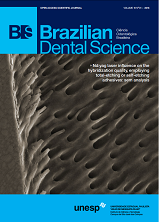Effect of etching with different hydrofluoric acid concentrations on bond strength between glazed feldspathic ceramic and metal brackets
DOI:
https://doi.org/10.14295/bds.2016.v19i1.1193Resumo
Objective – The aim of this study was evaluate the effect of etching with different hydrofluoric acid (HF) concentrations on the shear bond strength between glazed feldspathic ceramic and metal brackets. Materials and Methods – Seventy-five blocks of glazed feldspathic ceramic were produced and randomly allocated to 5 groups: Ctrl- silane application only; HF1- HF1%+silane; HF3- HF3%+silane; HF5- HF5%+silane; HF10- HF10%+silane (standard procedures: etching for 1 min + washing + drying + silanization). Metal brackets for upper central incisors (Edgewise Standard) were bonded on the ceramic surface with the use of an adhesive system and light-cured composite resin (TransbondTM XT, 3M). The specimens were aged for 60 days (thermocycling: 10000x at 5-55 °C; stored in distilled water at 37 °C). Shear testing was performed, and specimens were classified for their Adhesive-Remnant-Index (ARI). Topographical inspection and contact angle analysis of the etched ceramic surfaces were performed. Data were statistically analyzed using the non-parametric Kruskal-Wallis test. One-way ANOVA and post-hoc Tukey’s tests were applied to the contact angle data (p < 0.05). Results – No significant difference was detected between the shear bond strength of the groups; but surface etching had a significant influence on the contact angle results (p < 0.00001). The control group presented the highest mean contact angle (61.8 ± 17.2°). All specimens showed adhesive failure at the resin-ceramic interface. Conclusion – The tested HF concentrations did not significantly influence the obtained shear bond strength of metal brackets adhered to glazed feldspathic ceramic surfaces.
Keywords
Ceramics; Hydrofluoric acid; Adhesion; Brackets; Silanization.
Downloads
Downloads
Publicado
Como Citar
Edição
Seção
Licença
TRANSFERÊNCIA DE DIREITOS AUTORAIS E DECLARAÇÃO DE RESPONSABILIDADE
Toda a propriedade de direitos autorais do artigo "____________________________________________________________________" é transferido do autor(es) para a CIÊNCIA ODONTOLÓGICA BRASILEIRA, no caso do trabalho ser publicado. O artigo não foi publicado em outro lugar e não foi submetido simultaneamente para publicação em outra revista.
Vimos por meio deste, atestar que trabalho é original e não apresenta dados manipulados, fraude ou plágio. Fizemos contribuição científica significativa para o estudo e estamos cientes dos dados apresentados e de acordo com a versão final do artigo. Assumimos total responsabilidade pelos aspectos éticos do estudo.
Este texto deve ser impresso e assinado por todos os autores. A versão digitalizada deverá ser apresentada como arquivo suplementar durante o processo de submissão.




























